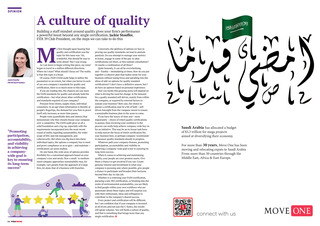




OPINION A culture of quality Building a staff mindset around quality gives your firms performance a powerful boost beyond any single certification. Jackie Stouffer, FIDI 39 Club President, on the steps we can take to do this M Jackie Stouffer FIDI 39 Club President Promoting participation, accountability, and visibility in achieving a companywide goal is key to ensuring its long-term success y first thought upon hearing that quality and certification was the topic for this issue was: Ah, wonderful, this should be easy to write about! But I was wrong. As I sat down to begin writing this piece, my mind began to travel in a million different directions. Where do I start? What should I focus on? The reality is that this topic is a beast. Of course, FIDIs FAIM audit helps to define the parameters to an extent, but when you factor in each of our own companys standards for quality and certification, there is so much more to this topic. If you are reading this, the chances are you meet the FAIM standards for quality and already hold the certification but what about other certifications and standards required of your company? Pressure from clients, supply chain, individual consumers: in an age when information is literally at peoples fingertips, the demand for your firm to prove itself only increases as more time passes. People want quantifiable data and metrics that demonstrate why they should choose your company over a competitor. The FAIM audit gives us all a solid foundation and a leg-up, especially with the requirements incorporated into the most recent round of audits regarding sustainability, the wider scope of ESG and risk management, and cybersecurity. But when you dig down into these individual topics, the options a company has to meet and prove compliance so as to gain and maintain certification can seem endless. On one hand, this wide array of options provides flexibility for a customised approach based on your companys size and needs. How a small- to mediumsized company approaches sustainability may, for example, vary greatly from the approach of a large firm, let alone that of a business with branches. Conversely, the plethora of options we face in proving our quality standards can lead to analysis paralysis. Do you attempt to manage your metrics in house, engage in some of the pay-to-play certifications out there, or hire outside consultation? Or maybe a combination of all three? Quite honestly, it can all be overwhelming and frankly intimidating at times. How do you put together a cohesive plan that makes sense for your business without losing focus and spiralling into the abyss of add-on options for quality standard certifications? I dont have a definitive answer, but I do have an opinion based on personal experience. How you tackle this growing arena will depend on what is driving the need for change. Is the demand for a quality standard self-driven, mainly from within the company, or required by external factors to sustain your business? Best case, the choice to pursue a certification may be a bit of both selfdriven foresight from the company meant to ensure a sustainable business plan in the years to come. If you have the luxury of time and more importantly choice of which quality certifications to pursue, then involving your workforce in the process can really help achieve company-wide buy-in for an initiative. This may be an in-house task force to help narrow the focus of which certification fits your business best, or perhaps company scoreboards to measure quality standards already in progress. Whatever path your company chooses, promoting participation, accountability and visibility in achieving a company-wide goal is key to ensuring its long-term success. When it comes to achieving and maintaining quality, your people are your greatest assets. Give them a chance to get involved if you can. Create genuine interest and investment in what your company is pursuing and, where possible, give people a chance to participate and broaden their horizons beyond their day-to-day job. Whether it is renewing your FAIM certification, pursuing a new ISO certification, or breaking into the realm of environmental sustainability, you are likely to find people within your own workforce who are passionate about these topics and will surprise you with their enthusiasm, ideas and willingness to contribute to the companys shared success. Every project and certification will be different, but I am confident that if your company is invested at all levels (and not just the C-Suite), the results will speak volumes. You will build a culture of quality, and that is something that brings more than any single certification. 54 FF312 Dec_Feb 23 pp54-55 FIDI 39 Club opinion.indd 54 05/12/2023 09:19